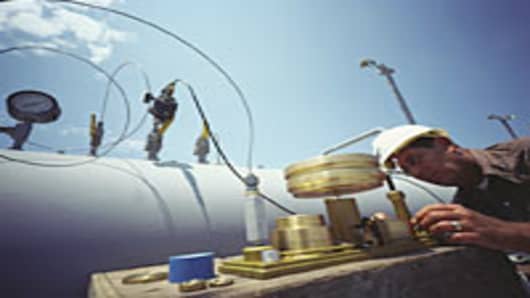U.S. energy producers’ recent successes in extracting natural gas from shale may have contributed to a price-dampening oversupply for now, but it’s also spurring tens of billions of dollars in capital investments by a reinvigorated industry.
Investments in pipelines and other natural gas infrastructure are expected to enter the trillions of dollars over the next two to three decades, with heavy investment in the near term.
“The gas business in North America has suddenly gone through a dramatic revolution,” as new horizontal drilling and hydraulic fracturing technologies have allowed access to tremendous natural gas resources, notes industry consultant James Jensen, president of Jensen Associates of Weston, Mass.
The industry needs new pipelines to accommodate the significant gas resources being discovered in places where it previously wasn’t found, he said, noting also that "fracking" is leading producers to oil.
Shale gas is also sparking capital expenditures by chemical producers that use natural gas as fuel and feedstock, and by other energy-intensive industries, and may prompt investment in natural gas-fueled power generation as well.
The shale discoveries could potentially shift the United States to an export market, as well, as shale gas is expected to reduce reliance on liquefied natural gas imports and pare U.S. electricity prices.
“The United States has really changed in the past three or four years its energy profile, and that is why we’re seeing this step up in infrastructure investment,” says John Parry, principal energy financial analyst at IHS Herold, an energy company and transaction research arm of IHS Global Insight.
“This is an evolving situation,” Parry says. “Nothing is clear cut.”
Unconventional gas activity — shale gas, coal bed methane and tight sands — accounted for 53 percent of total US. natural gas production in 2010 and is projected to rise to 79 percent by 2035, according to a new study by IHS, which was prepared for America’s Natural Gas Alliance.
Nearly $3.2 trillion in cumulative investments in the development of unconventional gas are anticipated from 2010 to 2035, the IHS study said. Shale gas investments should account for nearly $1.9 trillion, with capital expenditures especially strong in the near future, growing from $33 billion in 2010 to $48 billion by 2015, the IHS said in a similar report in December.
Shale gas accounted for 27 percent of U.S. natural gas production by 2010, reached 34 percent last September, and is projected to grow to 43 percent by 2015 and 60 percent by 2035, according to IHS.
“Nearly $1.9 trillion in shale gas capital investments are expected between 2010 and 2035,” the report said. “Capital expenditures are especially strong in the near future, growing from $33 billion in 2010 to $48 billion by 2015.”
The “shale plays,” or formations, are attracting major investments, in part because they’re also leading to discovery of oil and other liquid fossil fuels, industry experts note. North Dakota should soon surpass Alaska as an oil producer, Jensen said.
Shale plays are creating a “huge market” for oil and gas transporters, which are investing billions now, according to IHS.
The pipeline segment includes such names as Kinder Morgan, which calls itself the largest U.S. natural gas transporter and storage operator, and its related businesses, including newly acquired El Paso; Williams Companies; Spectra Energy; Enterprise Products Partners; and Enbridge.
El Paso made about $8 billion in capital investments in recent years, which attracted Kinder Morgan, says Parry.
Major oil and gas companies, including Exxon Mobil, and independent producers, such as Anadarko Petroleum and Apache, are also investing in the shale plays.
Apache, which is already involved in shale development and unconventional gas drilling, says it is “scouring geologic maps for opportunities.”
Exxon Mobil, which expanded its natural gas position when it bought XTO Energy for roughly $30 billion two years ago, reiterated its support for gas during its May 30 shareholder meeting.
CEO Rex Tillerson told investors Exxon Mobil is looking into exporting U.S. and Canadian natural gas, and predicted natural gas will surpass coal as the second-largest energy type, after oil, by 2040.
Yet, despite all the bold estimates and high hopes, trouble is on the horizon.
Big investment in natural gas may taper in two or three years, unless the industry is allowed to export liquid natural gas through coastal terminals, necessitating more pipelines and liquefying facilities, says IHS’ Parry.
Export LNG projects are very capital intensive, in the multibillions of dollars, and it’s unclear how many will go forward, says Jensen. Political pressure over environmental issues is making it tougher to build pipelines, although many will go forward, the industry consultant says.
Consultancy ICG International projected in a 2009 report that 3,300 miles of transmission pipeline would be added between 2009 and 2035.
Duane Grubert, senior energy analyst at Susquehanna Financial Group, expects an oversupply situation for many years.
While low natural gas prices may be good for the country and other industries, they’re not helpful to producers, notes Grubert, whose firm is now negative on gas production. Many companies have overinvested in gas.
“They’ve just found too much gas,” he said.
For now, that is.


